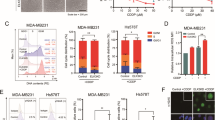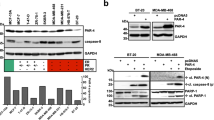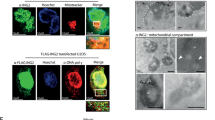Abstract
CIB1 is a 22-kDa regulatory protein previously implicated in cell survival and proliferation. However, the mechanism by which CIB1 regulates these processes is poorly defined. Here, we report that CIB1 depletion in SK-N-SH neuroblastoma and MDA-MB-468 breast cancer cells promotes non-apoptotic, caspase-independent cell death that is not initiated by increased outer mitochondrial membrane permeability or translocation of apoptosis-inducing factor to the nucleus. Instead, cell death requires nuclear GAPDH accumulation. Furthermore, CIB1 depletion disrupts two commonly dysregulated, oncogenic pathways—PI3K/AKT and Ras/MEK/ERK, resulting in a synergistic mechanism of cell death, which was mimicked by simultaneous pharmacological inhibition of both pathways, but not either pathway alone. In defining each pathway’s contributions, we found that AKT inhibition alone maximally induced GAPDH nuclear accumulation, whereas MEK/ERK inhibition alone had no effect on GAPDH localization. Concurrent GAPDH nuclear accumulation and ERK inhibition were required, however, to induce a significant DNA damage response, which was critical to subsequent cell death. Collectively, our results indicate that CIB1 is uniquely positioned to regulate PI3K/AKT and MEK/ERK signaling and that simultaneous disruption of these pathways synergistically induces a nuclear GAPDH-dependent cell death. The mechanistic insights into cell death induced by CIB1 interference suggest novel molecular targets for cancer therapy.
This is a preview of subscription content, access via your institution
Access options
Subscribe to this journal
Receive 50 print issues and online access
$259.00 per year
only $5.18 per issue
Buy this article
- Purchase on Springer Link
- Instant access to full article PDF
Prices may be subject to local taxes which are calculated during checkout







Similar content being viewed by others
References
McCubrey JA, Steelman LS, Abrams SL, Lee JT, Chang F, Bertrand FE et al. Roles of the RAF/MEK/ERK and PI3K/PTEN/AKT pathways in malignant transformation and drug resistance. Adv Enzyme Regul 2006; 46: 249–279.
Slack-Davis JK, Eblen ST, Zecevic M, Boerner SA, Tarcsafalvi A, Diaz HB et al. PAK1 phosphorylation of MEK1 regulates fibronectin-stimulated MAPK activation. J Cell Biol 2003; 162: 281–291.
Huynh N, Liu KH, Baldwin GS, He H . P21-activated kinase 1 stimulates colon cancer cell growth and migration/invasion via ERK- and AKT-dependent pathways. Biochim Biophys Acta 2010; 1803: 1106–1113.
Grant S . Cotargeting survival signaling pathways in cancer. J Clin Invest 2008; 118: 3003–3006.
Datta SR, Dudek H, Tao X, Masters S, Fu H, Gotoh Y et al. Akt phosphorylation of BAD couples survival signals to the cell-intrinsic death machinery. Cell 1997; 91: 231–241.
Fang X, Yu S, Eder A, Mao M, Bast RC, Boyd D et al. Regulation of BAD phosphorylation at serine 112 by the Ras-mitogen-activated protein kinase pathway. Oncogene 1999; 18: 6635–6640.
She QB, Halilovic E, Ye Q, Zhen W, Shirasawa S, Sasazuki T et al. 4E-BP1 is a key effector of the oncogenic activation of the AKT and ERK signaling pathways that integrates their function in tumors. Cancer Cell 2010; 18: 39–51.
Dent P, Curiel DT, Fisher PB, Grant S . Synergistic combinations of signaling pathway inhibitors: mechanisms for improved cancer therapy. Drug Resist Updat 2009; 12: 65–73.
Gentry HR, Singer AU, Betts L, Yang C, Ferrara JD, Sondek J et al. Structural and biochemical characterization of CIB1 delineates a new family of EF-hand-containing proteins. J Biol Chem 2005; 280: 8407–8415.
Naik UP, Patel PM, Parise LV . Identification of a novel calcium-binding protein that interacts with the integrin alphaIIb cytoplasmic domain. J Biol Chem 1997; 272: 4651–4654.
Leisner TM, Liu M, Jaffer ZM, Chernoff J, Parise LV . Essential role of CIB1 in regulating PAK1 activation and cell migration. J Cell Biol 2005; 170: 465–476.
Yoon KW, Cho JH, Lee JK, Kang YH, Chae JS, Kim YM et al. CIB1 functions as a Ca(2+)-sensitive modulator of stress-induced signaling by targeting ASK1. Proc Natl Acad Sci USA 2009; 106: 17389–17394.
Zayed MA, Yuan W, Chalothorn D, Faber JE, Parise LV . Tumor growth and angiogenesis is impaired in CIB1 knockout mice. J Angiogenes Res 2010; 2: 17.
Yuan W, Leisner TM, McFadden AW, Clark S, Hiller S, Maeda N et al. CIB1 is essential for mouse spermatogenesis. Mol Cell Biol 2006; 26: 8507–8514.
Zayed MA, Yuan W, Leisner TM, Chalothorn D, McFadden AW, Schaller MD et al. CIB1 regulates endothelial cells and ischemia-induced pathological and adaptive angiogenesis. Circ Res 2007; 101: 1185–1193.
Broker LE, Kruyt FA, Giaccone G . Cell death independent of caspases: a review. Clin Cancer Res 2005; 11: 3155–3162.
Lartigue L, Kushnareva Y, Seong Y, Lin H, Faustin B, Newmeyer DD . Caspase-independent mitochondrial cell death results from loss of respiration, not cytotoxic protein release. Mol Biol Cell 2009; 20: 4871–4884.
Sawa A, Khan AA, Hester LD, Snyder SH . Glyceraldehyde-3-phosphate dehydrogenase: nuclear translocation participates in neuronal and nonneuronal cell death. Proc Natl Acad Sci USA 1997; 94: 11669–11674.
Hara MR, Thomas B, Cascio MB, Bae BI, Hester LD, Dawson VL et al. Neuroprotection by pharmacologic blockade of the GAPDH death cascade. Proc Natl Acad Sci USA 2006; 103: 3887–3889.
Hara MR, Snyder SH . Nitric oxide-GAPDH-Siah: a novel cell death cascade. Cell Mol Neurobiol 2006; 26: 527–538.
Kornberg MD, Sen N, Hara MR, Juluri KR, Nguyen JV, Snowman AM et al. GAPDH mediates nitrosylation of nuclear proteins. Nat Cell Biol 2010; 12: 1094–1100.
Sen N, Hara MR, Kornberg MD, Cascio MB, Bae BI, Shahani N et al. Nitric oxide-induced nuclear GAPDH activates p300/CBP and mediates apoptosis. Nat Cell Biol 2008; 10: 866–873.
Tristan C, Shahani N, Sedlak TW, Sawa A . The diverse functions of GAPDH: views from different subcellular compartments. Cell Signal 2011; 23: 317–323.
Sastry KS, Karpova Y, Kulik G . Epidermal growth factor protects prostate cancer cells from apoptosis by inducing BAD phosphorylation via redundant signaling pathways. J Biol Chem 2006; 281: 27367–27377.
Frame S, Cohen P . GSK3 takes centre stage more than 20 years after its discovery. Biochem J 2001; 359 (Part 1): 1–16.
Mills JR, Malina A, Pelletier J . Inhibiting mitochondrial-dependent proteolysis of Mcl-1 promotes resistance to DNA damage. Cell Cycle 2012; 11: 88–98.
Nijhawan D, Fang M, Traer E, Zhong Q, Gao W, Du F et al. Elimination of Mcl-1 is required for the initiation of apoptosis following ultraviolet irradiation. Genes Dev 2003; 17: 1475–1486.
Kwon HJ, Rhim JH, Jang IS, Kim GE, Park SC, Yeo EJ . Activation of AMP-activated protein kinase stimulates the nuclear localization of glyceraldehyde 3-phosphate dehydrogenase in human diploid fibroblasts. Exp Mol Med 2010; 42: 254–269.
Rogakou EP, Pilch DR, Orr AH, Ivanova VS, Bonner WM . DNA double-stranded breaks induce histone H2AX phosphorylation on serine 139. J Biol Chem 1998; 273: 5858–5868.
Sancar A, Lindsey-Boltz LA, Unsal-Kacmaz K, Linn S . Molecular mechanisms of mammalian DNA repair and the DNA damage checkpoints. Annu Rev Biochem 2004; 73: 39–85.
Sherr CJ, McCormick F . The RB and p53 pathways in cancer. Cancer Cell 2002; 2: 103–112.
Yuan J, Kramer A, Matthess Y, Yan R, Spankuch B, Gatje R et al. Stable gene silencing of cyclin B1 in tumor cells increases susceptibility to taxol and leads to growth arrest in vivo. Oncogene 2006; 25: 1753–1762.
Kragten E, Lalande I, Zimmermann K, Roggo S, Schindler P, Muller D et al. Glyceraldehyde-3-phosphate dehydrogenase, the putative target of the antiapoptotic compounds CGP 3466 and R-(−)-deprenyl. J Biol Chem 1998; 273: 5821–5828.
Nakajima H, Amano W, Kubo T, Fukuhara A, Ihara H, Azuma YT et al. Glyceraldehyde-3-phosphate dehydrogenase aggregate formation participates in oxidative stress-induced cell death. The Journal of biological chemistry 2009; 284: 34331–34341.
Mohr S, Hallak H, de Boitte A, Lapetina EG, Brune B . Nitric oxide-induced S-glutathionylation and inactivation of glyceraldehyde-3-phosphate dehydrogenase. J Biol Chem 1999; 274: 9427–9430.
Broniowska KA, Hogg N . Differential mechanisms of inhibition of glyceraldehyde-3-phosphate dehydrogenase by S-nitrosothiols and NO in cellular and cell-free conditions. Am J Physiol Heart Circ Physiol 2010; 299: H1212–H1219.
Xu Y . Induction of genetic instability by gain-of-function p53 cancer mutants. Oncogene 2008; 27: 3501–3507.
Schmitz HD . Reversible nuclear translocation of glyceraldehyde-3-phosphate dehydrogenase upon serum depletion. Eur J Cell Biol 2001; 80: 419–427.
Colell A, Green DR, Ricci JE . Novel roles for GAPDH in cell death and carcinogenesis. Cell Death Differ 2009; 16: 1573–1581.
Kodama R, Kondo T, Yokote H, Jing X, Sawada T, Hironishi M et al. Nuclear localization of glyceraldehyde-3-phosphate dehydrogenase is not involved in the initiation of apoptosis induced by 1-Methyl-4-phenyl-pyridium iodide (MPP+). Genes Cells 2005; 10: 1211–1219.
Phadke MS, Krynetskaia NF, Mishra AK, Krynetskiy E . Glyceraldehyde 3-phosphate dehydrogenase depletion induces cell cycle arrest and resistance to antimetabolites in human carcinoma cell lines. J Pharmacol ExpTher 2009; 331: 77–86.
Xing C, LaPorte JR, Barbay JK, Myers AG . Identification of GAPDH as a protein target of the saframycin antiproliferative agents. Proc Natl Acad Sci USA 2004; 101: 5862–5866.
Arias-Romero LE, Villamar-Cruz O, Pacheco A, Kosoff R, Huang M, Muthuswamy SK et al. A Rac-Pak signaling pathway is essential for ErbB2-mediated transformation of human breast epithelial cancer cells. Oncogene 2010; 29: 5839–5849.
Azam S, Jouvet N, Jilani A, Vongsamphanh R, Yang X, Yang S et al. Human glyceraldehyde-3-phosphate dehydrogenase plays a direct role in reactivating oxidized forms of the DNA repair enzyme APE1. J Biol Chem 2008; 283: 30632–30641.
Dastoor Z, Dreyer JL . Potential role of nuclear translocation of glyceraldehyde-3-phosphate dehydrogenase in apoptosis and oxidative stress. J Cell Sci 2001; 114 (Part 9): 1643–1653.
Golding SE, Rosenberg E, Neill S, Dent P, Povirk LF, Valerie K . Extracellular signal-related kinase positively regulates ataxia telangiectasia mutated, homologous recombination repair, and the DNA damage response. Cancer Res 2007; 67: 1046–1053.
Dai Y, Chen S, Pei XY, Almenara JA, Kramer LB, Venditti CA et al. Interruption of the Ras/MEK/ERK signaling cascade enhances Chk1 inhibitor-induced DNA damage in vitro and in vivo in human multiple myeloma cells. Blood 2008; 112: 2439–2449.
Castedo M, Perfettini JL, Roumier T, Andreau K, Medema R, Kroemer G . Cell death by mitotic catastrophe: a molecular definition. Oncogene 2004; 23: 2825–2837.
Carujo S, Estanyol JM, Ejarque A, Agell N, Bachs O, Pujol MJ . Glyceraldehyde 3-phosphate dehydrogenase is a SET-binding protein and regulates cyclin B-cdk1 activity. Oncogene 2006; 25: 4033–4042.
Chambard JC, Lefloch R, Pouyssegur J, Lenormand P . ERK implication in cell cycle regulation. Biochim Biophys Acta 2007; 1773: 1299–1310.
Mikami I, Zhang F, Hirata T, Okamoto J, Koizumi K, Shimizu K et al. Inhibition of activated phosphatidylinositol 3-kinase/AKT pathway in malignant pleural mesothelioma leads to G1 cell cycle arrest. Oncol Rep 2010; 24: 1677–1681.
She QB, Chandarlapaty S, Ye Q, Lobo J, Haskell KM, Leander KR et al. Breast tumor cells with PI3K mutation or HER2 amplification are selectively addicted to Akt signaling. PLoS ONE 2008; 3: e3065.
Milosevic J, Bulau P, Mortz E, Eickelberg O . Subcellular fractionation of TGF-beta1-stimulated lung epithelial cells: a novel proteomic approach for identifying signaling intermediates. Proteomics 2009; 9: 1230–1240.
Acknowledgements
We thank members of the Parise, Cook and A Sancar laboratories, Drs Yue Xiong, Matthew Torres, and Howard Fried for critical review and suggestions. We also thank Dr Akira Sawa for generously providing GAPDH plasmids. Special thanks to Dr H Fried and Andrew McFadden for lentiviral plasmid construction. This work was funded by the postdoctoral fellowship grant HL07149T32 (CM) and 5R01HL092544 (LVP) from the NIH.
Author information
Authors and Affiliations
Corresponding author
Ethics declarations
Competing interests
The authors declare no conflict of interest.
Additional information
Supplementary Information accompanies the paper on the Oncogene website
Rights and permissions
About this article
Cite this article
Leisner, T., Moran, C., Holly, S. et al. CIB1 prevents nuclear GAPDH accumulation and non-apoptotic tumor cell death via AKT and ERK signaling. Oncogene 32, 4017–4027 (2013). https://doi.org/10.1038/onc.2012.408
Received:
Revised:
Accepted:
Published:
Issue Date:
DOI: https://doi.org/10.1038/onc.2012.408
Keywords
This article is cited by
-
ROS production by mitochondria: function or dysfunction?
Oncogene (2024)
-
CHIP-mediated CIB1 ubiquitination regulated epithelial–mesenchymal transition and tumor metastasis in lung adenocarcinoma
Cell Death & Differentiation (2021)
-
Gene expression is stable in a complete CIB1 knockout keratinocyte model
Scientific Reports (2020)
-
CIB1 depletion with docetaxel or TRAIL enhances triple-negative breast cancer cell death
Cancer Cell International (2019)
-
Role of a polyphenol-enriched preparation on chemoprevention of mammary carcinoma through cancer stem cells and inflammatory pathways modulation
Journal of Translational Medicine (2016)



